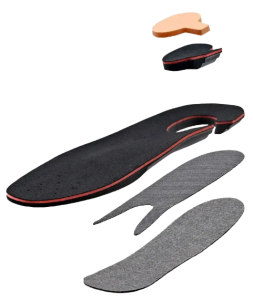
What are Foot Orthoses and what are they for?
Index
Foot care goes far beyond choosing good footwear. When pain or an alteration in the way you walk appears, orthotics can be a great tool for restoring comfort and mobility. But what exactly are orthotics, how are they different from insoles, and when is it necessary to use them?
In this article we explain what foot orthoses are, what they are for and what alternatives exist if you are looking for an effective but not so personalized or invasive solution.
What are Foot Orthoses
Orthoses are external orthopedic devices designed to modify biomechanical aspects of the body. In the case of the foot, we are talking about elements that are placed on the lower part of the foot or that wrap around part of the structure to:
- Correcting malformations or postural alterations
- Reduce or eliminate pain
- Stabilizing and controlling movement
- Prevent progression of a pathology
Unlike other products such as ergonomic comfort Inoles, orthoses are designed for a specific therapeutic purpose. Their design is usually customized, following a medical or podiatric assessment, and in many cases they require custom manufacturing.
Types of Foot Orthoses
Within the orthopedic field there are different types of foot orthoses, depending on the area of the foot to be corrected or protected. Some of the most common are:
- Plantar Orthoses: Similar in appearance to an Insole, but designed to fulfill a very specific function. They are used in cases of plantar fasciitis, flat feet, pes cavus or alterations in the footprint.
- Digital Orthoses: They are placed on the toes, especially on the first toe or “big toe”, and are used to correct deformities such as hallux valgus (bunions) or hallux rigidus (arthrosis of the big toe).
- Relief Orthoses: They help redistribute pressure and relieve very painful areas, such as in cases of heel spurs or plantar ulcers.
- Nocturnal Orthoses: They are designed to be worn while sleeping. They serve to stretch the plantar fascia or maintain proper positioning of the foot and ankle during rest.
What is the difference between Orthoses and Insole?
The main difference between an orthosis and an insole is in its purpose and degree of customization.
- Orthoses are usually custom-made and are intended to correct a specific condition, for example, to reduce stiffness in the big toe, align a flat foot or relieve a specific pressure point.
- Inoles can be ergonomic, anatomical or standard, and are primarily aimed at improving comfort, stability and preventing the onset of pain. Some, such as orthopedic Inoles, are designed with a therapeutic approach, but many others are simply intended to improve the footprint or cushion impact.
Both elements can coexist. In fact, in some treatments, orthoses are combined with Inoles to reinforce the therapeutic effect or to alleviate pain while correcting the footprint.
Alternative or Added: Insole Smou
At Smou we have been working for years on solutions that, without being orthotics in the strict sense of the word, incorporate many of its advantages. The Smou Hallux Insole, for example, is designed to relieve pain and improve stability in cases of hallux rigidus or hallux valgus (bunions and arthrosis of the big toe).
We also have Inoles designed to prevent and alleviate pain in most foot pathologies. This is the case of our Smou Complet, a versatile and effective option that helps to relieve the most sensitive areas, better distribute weight and absorb the impact of each step.
They are designed to provide support and comfort in everyday life, without the need for a customized orthosis. If you are looking for a practical solution that combines comfort and efficiency, the Smou Complet can be a great ally.
When to See a Specialist
Orthotics are a very useful solution, but they also require a prior professional assessment. If you have persistent pain, visible alterations in the foot, balance problems or discomfort when walking, it is best to see a podiatrist or orthopedic specialist.
A professional will be able to evaluate your case, perform the necessary tests and recommend the most appropriate treatment, whether it is a customized orthosis or a functional Insole that relieves pain.
Taking care of your feet is key to moving freely and without discomfort. If you notice pain or discomfort, don’t let it go: there are solutions that can make a difference.
Did you like this content? Share it on your social networks:



